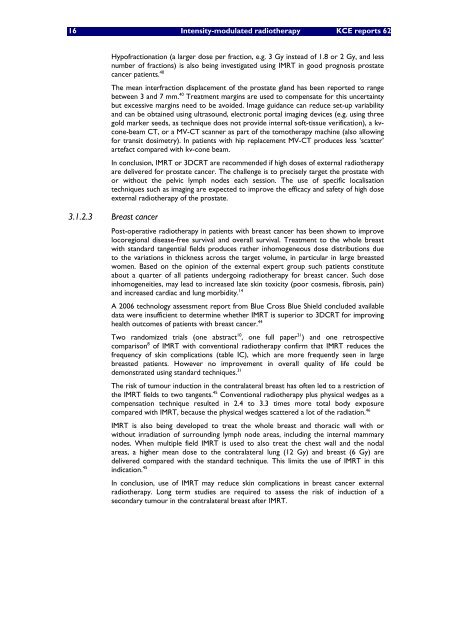Intensiteitsgemoduleerde Radiotherapie (IMRT) - KCE
Intensiteitsgemoduleerde Radiotherapie (IMRT) - KCE
Intensiteitsgemoduleerde Radiotherapie (IMRT) - KCE
You also want an ePaper? Increase the reach of your titles
YUMPU automatically turns print PDFs into web optimized ePapers that Google loves.
16 Intensity-modulated radiotherapy <strong>KCE</strong> reports 62<br />
Hypofractionation (a larger dose per fraction, e.g. 3 Gy instead of 1.8 or 2 Gy, and less<br />
number of fractions) is also being investigated using <strong>IMRT</strong> in good prognosis prostate<br />
cancer patients. 40<br />
The mean interfraction displacement of the prostate gland has been reported to range<br />
between 3 and 7 mm. 40 Treatment margins are used to compensate for this uncertainty<br />
but excessive margins need to be avoided. Image guidance can reduce set-up variability<br />
and can be obtained using ultrasound, electronic portal imaging devices (e.g. using three<br />
gold marker seeds, as technique does not provide internal soft-tissue verification), a kvcone-beam<br />
CT, or a MV-CT scanner as part of the tomotherapy machine (also allowing<br />
for transit dosimetry). In patients with hip replacement MV-CT produces less ‘scatter’<br />
artefact compared with kv-cone beam.<br />
In conclusion, <strong>IMRT</strong> or 3DCRT are recommended if high doses of external radiotherapy<br />
are delivered for prostate cancer. The challenge is to precisely target the prostate with<br />
or without the pelvic lymph nodes each session. The use of specific localisation<br />
techniques such as imaging are expected to improve the efficacy and safety of high dose<br />
external radiotherapy of the prostate.<br />
3.1.2.3 Breast cancer<br />
Post-operative radiotherapy in patients with breast cancer has been shown to improve<br />
locoregional disease-free survival and overall survival. Treatment to the whole breast<br />
with standard tangential fields produces rather inhomogeneous dose distributions due<br />
to the variations in thickness across the target volume, in particular in large breasted<br />
women. Based on the opinion of the external expert group such patients constitute<br />
about a quarter of all patients undergoing radiotherapy for breast cancer. Such dose<br />
inhomogeneities, may lead to increased late skin toxicity (poor cosmesis, fibrosis, pain)<br />
and increased cardiac and lung morbidity. 14<br />
A 2006 technology assessment report from Blue Cross Blue Shield concluded available<br />
data were insufficient to determine whether <strong>IMRT</strong> is superior to 3DCRT for improving<br />
health outcomes of patients with breast cancer. 44<br />
Two randomized trials (one abstract 10 , one full paper 31 ) and one retrospective<br />
comparison 8 of <strong>IMRT</strong> with conventional radiotherapy confirm that <strong>IMRT</strong> reduces the<br />
frequency of skin complications (table IC), which are more frequently seen in large<br />
breasted patients. However no improvement in overall quality of life could be<br />
demonstrated using standard techniques. 31<br />
The risk of tumour induction in the contralateral breast has often led to a restriction of<br />
the <strong>IMRT</strong> fields to two tangents. 45 Conventional radiotherapy plus physical wedges as a<br />
compensation technique resulted in 2.4 to 3.3 times more total body exposure<br />
compared with <strong>IMRT</strong>, because the physical wedges scattered a lot of the radiation. 46<br />
<strong>IMRT</strong> is also being developed to treat the whole breast and thoracic wall with or<br />
without irradiation of surrounding lymph node areas, including the internal mammary<br />
nodes. When multiple field <strong>IMRT</strong> is used to also treat the chest wall and the nodal<br />
areas, a higher mean dose to the contralateral lung (12 Gy) and breast (6 Gy) are<br />
delivered compared with the standard technique. This limits the use of <strong>IMRT</strong> in this<br />
indication. 45<br />
In conclusion, use of <strong>IMRT</strong> may reduce skin complications in breast cancer external<br />
radiotherapy. Long term studies are required to assess the risk of induction of a<br />
secondary tumour in the contralateral breast after <strong>IMRT</strong>.

















